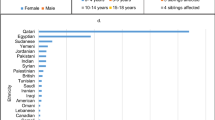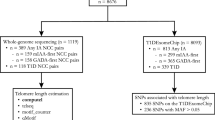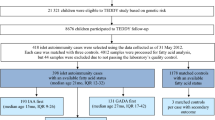Abstract
Objective:
Human leukocyte antigen DQ (HLA-DQ) genetic factors and islet autoantibodies are strongly associated with type 1 diabetes (T1D) and are currently used to predict T1D. This study examined whether islet autoantibodies in the cord blood of newborns to nondiabetic mothers were associated with the (T1D) high-risk genotype HLA-DQ2/8, gestational infections or both.
Study Design:
Cord blood samples were taken from 33 683 newborns and used for HLA typing and analyses of islet autoantibodies. Parents completed questionnaires when the child was 2 months of age.
Result:
The prevalence of newborn islet autoantibodies consistently varied with season over 4 years (P<0.0001); lowest in first quarter (1.2%) and highest in third (2.4%). Cord blood islet autoantibodies were associated with HLA-DQ2/8 in the second (OR, 2.30; P=0.02), third (OR, 2.12; P=0.008) and fourth quarters (OR, 2.49; P=0.007), but not in the first (OR, 1.13). Reported gastroenteritis was additionally associated with islet autoantibodies in the third quarter (OR, 1.80, P=0.04).
Conclusion:
An association between HLA and islet autoimmunity may depend on environmental exposure during pregnancy. Follow-up of mothers and children will determine risk of T1D.
This is a preview of subscription content, access via your institution
Access options
Subscribe to this journal
Receive 12 print issues and online access
$259.00 per year
only $21.58 per issue
Buy this article
- Purchase on Springer Link
- Instant access to full article PDF
Prices may be subject to local taxes which are calculated during checkout


Similar content being viewed by others
References
Notkins AL, Lernmark A . Autoimmune type 1 diabetes: resolved and unresolved issues. J Clin Invest 2001; 108: 1247–1252.
Eisenbarth GS . Prediction of type 1 diabetes: the natural history of the prediabetic period. Adv Exp Med Biol 2004; 552: 268–290.
Pihoker C, Gilliam LK, Hampe CS, Lernmark A . Autoantibodies in diabetes. Diabetes 2005; 54 (Suppl 2): S52–S61.
Skyler JS, Diabetes Prevention Trial—Type I Diabetes Study Group. Effects of insulin in relatives of patients with type 1 diabetes mellitus. N Engl J Med 2002; 346: 1685–1691.
Gale EA, Bingley PJ, Emmett CL, Collier T . European Nicotinamide Diabetes Intervention Trial (ENDIT): a randomised controlled trial of intervention before the onset of type 1 diabetes. Lancet 2004; 363: 925–931.
Graham J, Hagopian WA, Kockum I, Li LS, Sanjeevi CB, Lowe RM et al. Genetic effects on age-dependent onset and islet cell autoantibody markers in type 1 diabetes. Diabetes 2002; 51: 1346–1355.
Rewers M, Bugawan TL, Norris JM, Blair A, Beaty B, Hoffman M et al. Newborn screening for HLA markers associated with IDDM: diabetes autoimmunity study in the young (DAISY). Diabetologia 1996; 39: 807–812.
Greener M . PANDA identifies babies at risk of developing type 1 diabetes. Mol Med Today 2000; 6: 3.
Ilonen J, Reijonen H, Knip M, Simell O . Population-based genetic screening for IDDM susceptibility as a source of HLA-genotyped control subjects. Diabetologia 1996; 39: 123.
Roll U, Christie MR, Fuchtenbusch M, Payton MA, Hawkes CJ, Ziegler AG . Perinatal autoimmunity in offspring of diabetic parents. The German Multicenter BABY-DIAB Study: detection of humoral immune responses to islet antigens in early childhood. Diabetes 1996; 45: 967–973.
Concannon P, Erlich HA, Julier C, Morahan G, Nerup J, Pociot F et al. Type 1 diabetes: evidence for susceptibility loci from four genome-wide linkage scans in 1435 multiplex families. Diabetes 2005; 54: 2995–3001.
Komulainen J, Kulmala P, Savola K, Lounamaa R, Ilonen J, Reijonen H et al. Clinical, autoimmune, and genetic characteristics of very young children with type 1 diabetes. Childhood Diabetes in Finland (DiMe) Study Group. Diabetes Care 1999; 22: 1950–1955.
Atkinson MA, Eisenbarth GS . Type 1 diabetes: new perspectives on disease pathogenesis and treatment. Lancet 2001; 358: 221–229.
Dahlquist G, Blom L, Tuvemo T, Nystrom L, Sandstrom A, Wall S . The Swedish Childhood Diabetes Study—results from a nine year case register and a one year case-referent study indicating that type 1 (insulin-dependent) diabetes mellitus is associated with both type 2 (non-insulin-dependent) diabetes mellitus and autoimmune disorders. Diabetologia 1989; 32: 2–6.
Olmos P, A'Hern R, Heaton DA, Millward BA, Risley D, Pyke DA et al. The significance of the concordance rate for type 1 (insulin-dependent) diabetes in identical twins. Diabetologia 1988; 31: 747–750.
Hyoty H, Taylor KW . The role of viruses in human diabetes. Diabetologia 2002; 45: 1353–1361.
Green A, Patterson CC . Trends in the incidence of childhood-onset diabetes in Europe 1989–1998. Diabetologia 2001; 44 (Suppl 3): B3–B8.
Pundziute-Lycka A, Dahlquist G, Nystrom L, Arnqvist H, Bjork E, Blohme G et al. The incidence of type I diabetes has not increased but shifted to a younger age at diagnosis in the 0–34 years group in Sweden 1983–1998. Diabetologia 2002; 45: 783–791.
Dahlquist GG, Ivarsson S, Lindberg B, Forsgren M . Maternal enteroviral infection during pregnancy as a risk factor for childhood IDDM. A population-based case-control study. Diabetes 1995; 44: 408–413.
Hyoty H, Hiltunen M, Knip M, Laakkonen M, Vahasalo P, Karjalainen J et al. A prospective study of the role of coxsackie B and other enterovirus infections in the pathogenesis of IDDM. Childhood Diabetes in Finland (DiMe) Study Group. Diabetes 1995; 44: 652–657.
Stene LC, Barriga K, Norris JM, Hoffman M, Klingensmith G, Erlich HA et al. Symptoms of common maternal infections in pregnancy and risk of islet autoimmunity in early childhood. Diabetes Care 2003; 26: 3136–3141.
Dahlquist G, Kallen B . Maternal-child blood group incompatibility and other perinatal events increase the risk for early-onset type 1 (insulin-dependent) diabetes mellitus. Diabetologia 1992; 35: 671–675.
Bingley PJ, Douek IF, Rogers CA, Gale EA . Influence of maternal age at delivery and birth order on risk of type 1 diabetes in childhood: prospective population based family study. Bart's-Oxford Family Study Group. BMJ 2000; 321: 420–424.
Blom L, Dahlquist G, Nystrom L, Sandstrom A, Wall S . The Swedish Childhood Diabetes Study—social and perinatal determinants for diabetes in childhood. Diabetologia 1989; 32: 7–13.
Stene LC, Barriga K, Norris JM, Hoffman M, Erlich HA, Eisenbarth GS et al. Perinatal factors and development of islet autoimmunity in early childhood: the diabetes autoimmunity study in the young. Am J Epidemiol 2004; 160: 3–10.
Stene LC, Magnus P, Lie RT, Sovik O, Joner G . Maternal and paternal age at delivery, birth order, and risk of childhood onset type 1 diabetes: population based cohort study. BMJ 2001; 323: 369.
Stene LC, Magnus P, Lie RT, Sovik O, Joner G . Birth weight and childhood onset type 1 diabetes: population based cohort study. BMJ 2001; 322: 889–892.
Lindberg B, Ivarsson SA, Landin-Olsson M, Sundkvist G, Svanberg L, Lernmark A . Islet autoantibodies in cord blood from children who developed type I (insulin-dependent) diabetes mellitus before 15 years of age. Diabetologia 1999; 42: 181–187.
Elfving AM, Lindberg BA, Nystrom L, Sundkvist G, Lernmark A, Ivarsson SA . Islet autoantibodies in cord blood from patients who developed type 1 diabetes mellitus at 15–30 years of age. Autoimmunity 2003; 36: 227–231.
Koczwara K, Bonifacio E, Ziegler AG . Transmission of maternal islet antibodies and risk of autoimmune diabetes in offspring of mothers with type 1 diabetes. Diabetes 2004; 53: 1–4.
Ivarsson SA, Ackefors M, Carlsson A, Ekberg G, Falorni A, Kockum I et al. Glutamate decarboxylase antibodies in non-diabetic pregnancy precedes insulin-dependent diabetes in the mother but not necessarily in the offspring. Autoimmunity 1997; 26: 261–269.
Larsson K, Elding-Larsson H, Cederwall E, Kockum K, Neiderud J, Sjoblad S et al. Genetic and perinatal factors as risk for childhood type 1 diabetes. Diabetes Metab Res Rev 2004; 20: 429–437.
Lernmark B, Elding-Larsson H, Hansson G, Lindberg B, Lynch K, Sjoblad S . Parent responses to participation in genetic screening for diabetes risk. Pediatr Diabetes 2004; 5: 174–181.
Larsson HE, Lynch K, Lernmark B, Nilsson A, Hansson G, Almgren P et al. Diabetes-associated HLA genotypes affect birthweight in the general population. Diabetologia 2005; 48: 1484–1491.
Grubin CE, Daniels T, Toivola B, Landin-Olsson M, Hagopian WA, Li L et al. A novel radioligand binding assay to determine diagnostic accuracy of isoform-specific glutamic acid decarboxylase antibodies in childhood IDDM. Diabetologia 1994; 37: 344–350.
Lan MS, Lu J, Goto Y, Notkins AL . Molecular cloning and identification of a receptor-type protein tyrosine phosphatase, IA-2, from human insulinoma. DNA Cell Biol 1994; 13: 505–514.
Adams SF . The seasonal variation in the onset of acute diabetes. Arch Intern Med 1926; 37: 861–864.
Joner G, Sovik O . Incidence, age at onset and seasonal variation of diabetes mellitus in Norwegian children, 1973–1977. Acta Paediatr Scand 1981; 70: 329–335.
Samuelsson U, Carstensen J, Lofman O, Nordfeldt S . Seasonal variation in the diagnosis of type 1 diabetes in south-east Sweden. Diabetes Res Clin Pract 2007; 76: 75–81.
Kimpimaki T, Kupila A, Hamalainen AM, Kukko M, Kulmala P, Savola K et al. The first signs of beta-cell autoimmunity appear in infancy in genetically susceptible children from the general population: the Finnish Type 1 Diabetes Prediction and Prevention Study. J Clin Endocrinol Metab 2001; 86: 4782–4788.
Rolandsson O, Hagg E, Janer M, Rutledge E, Gaur LK, Nilsson M et al. High GAD65 autoantibody levels in nondiabetic adults are associated with HLA but not with CTLA-4 or INS VNTR. J Intern Med 2003; 253: 447–453.
Larsson HE, Lynch K, Lernmark B, Hansson G, Lernmark A, Ivarsson SA . Relationship between increased relative birthweight and infections during pregnancy in children with a high-risk diabetes HLA genotype. Diabetologia 2007; 50: 1161–1169.
Elfving M . Number of islet autoantibodies present in newly-diagnosed type 1 diabetic children born to non-diabetic mothers is affected by islet autoantibodies present at birth. Pediatr Diabetes 2008 (in press).
Rewers M . Islet autoantibodies in cord blood: maternal, fetal, or neither? Diabetes Metab Res Rev 2002; 18: 2–4.
Acknowledgements
We thank Anita Nilsson, Barbro Gustavsson, Anastasia Katsarous and Hamideh Rastkhani, for expert technical assistance. The DiPiS study was made possible through a joint JDRF-Wallenberg Foundation grant in 1995 to 2000 but stalled by the Lund University Ethics Committee for 2 years. It was possible to complete the study through grants from the Medical Faculty of Lund University, the Swedish Research Council (grant no. 14064), the Swedish Diabetes Association, the Swedish Childhood Diabetes Fund, the UMAS Fund, the Skåne County Council and the National Institutes of Health (DK26910), the Terry Louise Gregg's Awarded, the Novo Nordisk Foundation, the Lion Club International District 101-5. Members of the DiPiS study group include: P Almgren, B Gustavsson, B Buveris-Svendburg, A Carlsson, E Cederwall, G Hansson, I Hansson, B Jönsson, K Kockum, H Elding Larsson, K Larsson, S Lindehammer, B Lindberg, J Neiderud, A Nilsson, M Pelkonen, J Heins, A Shalonie and S Sjöblad.
Author information
Authors and Affiliations
Consortia
Corresponding author
Rights and permissions
About this article
Cite this article
Lynch, K., Lernmark, B., Merlo, J. et al. Cord blood islet autoantibodies and seasonal association with the type 1 diabetes high-risk genotype. J Perinatol 28, 211–217 (2008). https://doi.org/10.1038/sj.jp.7211912
Received:
Revised:
Accepted:
Published:
Issue Date:
DOI: https://doi.org/10.1038/sj.jp.7211912
Keywords
This article is cited by
-
Recent applications of machine learning and deep learning models in the prediction, diagnosis, and management of diabetes: a comprehensive review
Diabetology & Metabolic Syndrome (2022)
-
Influence of early-life parental severe life events on the risk of type 1 diabetes in children: the DiPiS study
Acta Diabetologica (2018)
-
Type 1 diabetes mellitus
Nature Reviews Disease Primers (2017)
-
The 6 year incidence of diabetes-associated autoantibodies in genetically at-risk children: the TEDDY study
Diabetologia (2015)
-
Cord blood insulinoma-associated protein 2 autoantibodies are associated with increased risk of type 1 diabetes in the population-based Diabetes Prediction in Skåne study
Diabetologia (2015)



